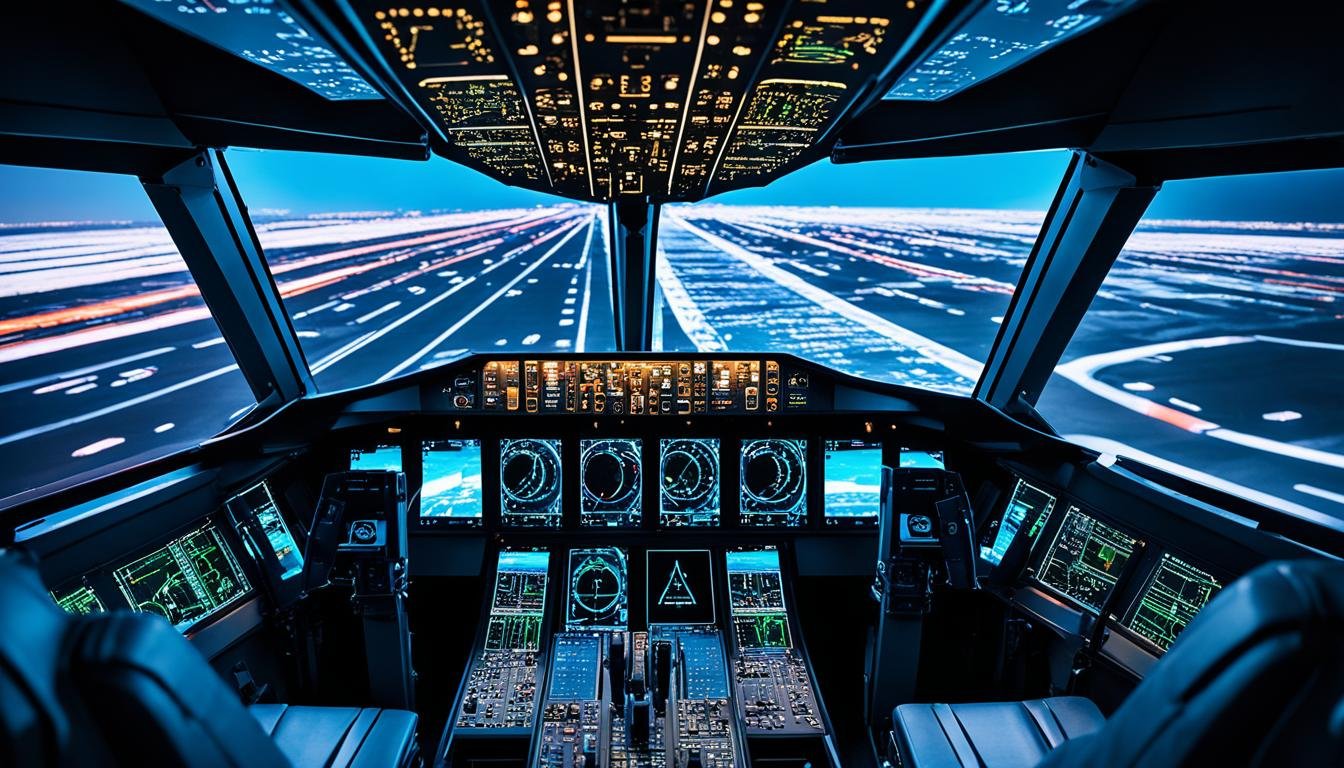Unmanned aerial vehicles (UAVs) and drones are now used for many tasks in aviation, showing how AI and robotics are becoming more common. Over the past 50 years, the number of people needed on commercial planes has dropped. Now, only two people are needed instead of the original five.
Artificial intelligence won’t replace pilots yet, but it will make flying easier and cheaper. It will also help airlines fly in a way that’s better for the planet. Airlines are perfect for using AI because they deal with a lot of complex data.
Recent AI advancements show what’s coming for aviation. This is exciting news for the industry.
Key Takeaways
- AI is changing aviation, helping with tasks like finding flights, setting prices, and tracking carbon emissions.
- Automation is making fewer crew members needed on flights, but humans are still key for emergencies and unexpected situations.
- AI-driven autopilots are already being used, showing how advanced automation is becoming a part of aviation.
- The idea of a plane controlled by AI is still new, and it might take years to fully replace human pilots with AI or robots.
- Before AI or robotic pilots become common, we need to work on public acceptance, rules, and the cost of these changes.
Introduction to AI and Aviation
The aviation industry has seen big changes thanks to artificial intelligence (AI). AI has greatly improved how efficient, safe, and personalized air travel is. From ai in aviation to ai-powered aviation systems, AI is now a key part of flying today.
The Rise of AI in the Aviation Industry
AI technology has quickly become a big part of the aviation world. ai flight systems have made planning flights, predicting weather, and maintaining aircraft better. Automated systems using ai-enabled aviation have made flying safer and cut costs for airlines everywhere.
Airlines use AI to make flying more personal. This includes customized flight suggestions, easy booking, and check-ins. AI also helps airlines set prices and manage their money better.
Current Applications of AI in Aviation
- AI-powered chatbots, like Singapore Airlines’ Kris, have made customer service better by understanding many languages and accents.
- AI-enabled maintenance systems can spot and fix problems, like engine issues, before they happen, making flying safer.
- AI helps plan flights and find the most fuel-efficient routes, saving money and reducing emissions.
- AI-powered robots on assembly lines have helped Boeing make aircraft faster and more efficiently.
- The UK government has funded Project Bluebird, the first AI system for air traffic control, to improve how planes move in the sky.
As the aviation world keeps changing, AI will play a bigger role. It will make flying better for passengers, make operations more efficient, and keep flying safe.
“Pilots are responsible for the lives of countless passengers, and AI co-pilots are designed to assist pilots in various aspects of their duties, enhancing safety, precision, and efficiency of flight operations.”
The Role of Human Pilots
Even with AI’s big steps forward, human pilots are still key in aviation. They have skills like making quick decisions in tough situations. Their training and real-world experience help them look at many factors at once. This includes weather, mechanical issues, and emergencies, and they make choices that put safety first.
Importance of Human Judgment and Decision-Making
Pilots are great at making quick, smart decisions. They can adjust to new situations fast, look at complex problems, and use their knowledge to keep everyone safe. This is very important in unexpected events or emergencies, where AI might not be as good at adapting.
Handling Emergencies and Unpredictable Situations
When things like sudden weather changes or mechanical problems happen, human pilots are at their best. They can quickly figure out what to do, think about their options, and make the right choice. Their training and experience help them handle complex situations well, often saving the day.
Human pilots are very important in aviation. AI is getting better, but pilots bring skills like judgment, decision-making, and flexibility that are key for safety and reliability in flying. Working together, human pilots and AI systems are shaping the future of flying, making it safer, more efficient, and more reliable for everyone.
“The human pilot is the most complex and the most variable component of the aviation system. Pilots’ skills, knowledge, and decision-making capabilities are critical to the safe and efficient operation of aircraft.”
AI Advancements in Flight Operations
The aviation industry has seen big steps forward in using artificial intelligence (AI) in flight operations. AI helps with automated flight planning, navigation, predictive maintenance, and monitoring aircraft health. This has changed how airlines work, making them more efficient and reliable.
Automated Flight Planning and Navigation
AI systems look at a lot of data, like weather, rules, and past flights. This helps make better flight plans. It makes pilots’ work easier and leads to better routes, less fuel use, and fewer emissions. AI also updates flight paths in real-time for unexpected changes, making flying safer and smoother.
Predictive Maintenance and Aircraft Health Monitoring
AI has changed aircraft maintenance. It uses predictive analytics to spot problems before they start. This means planes can be fixed before they break down, cutting downtime and saving money. Predictive maintenance aircraft and ai maintenance aviation solutions are making airlines more efficient and saving them money.
| Benefit | Impact |
|---|---|
| ai flight planning | Improved fuel efficiency and reduced carbon emissions |
| ai-powered navigation | Enhanced flight safety and on-time performance |
| ai maintenance aviation | Reduced maintenance costs and increased aircraft availability |
| predictive maintenance aircraft | Proactive identification of potential issues, minimizing unplanned downtime |
AI has made flying more efficient, reliable, and green. As AI gets better, air travel will keep getting smoother and more tailored to what passengers and airlines need.
Public Perception and Trust
As AI becomes more common in aviation, how people see and trust this new tech is key. Most passengers still prefer having a human pilot in charge. This gives them a sense of safety and comfort, especially in stressful times.
To gain trust in AI in flying, we need to change public views and tackle safety worries. The Air-Guardian system from MIT’s CSAIL has shown it can make flying safer and more reliable. It was backed by the U.S. Air Force, the Boeing Co., and others, showing how groups are working together to improve AI in flying.
But, human pilots are still much better at avoiding mistakes than AI systems. It could take years to make an AI system safe enough for flying. Slowly adding AI to flying, being open with the public, and teaching them about AI will help build trust. This is important for making people feel secure with AI pilots and accepting AI in flying.
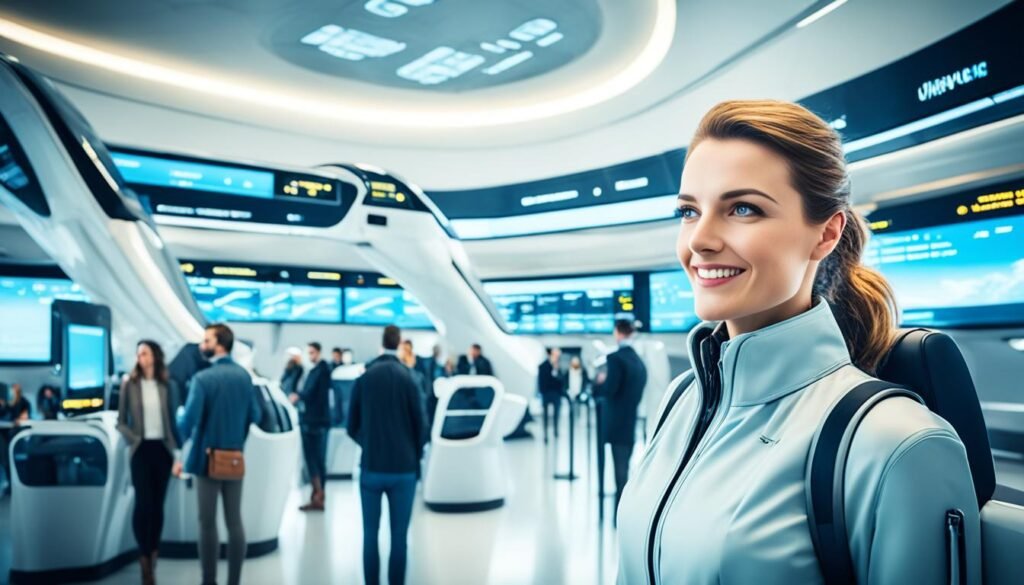
“The psychological comfort provided by a human presence helps build trust and reassurance, which is particularly important during high-stress situations and emergencies.”
Integration of AI and Human Pilots
The future of flying will blend artificial intelligence (AI) with human pilots. Instead of replacing pilots, AI will work alongside them. It will help with tasks like navigation and analyzing data, making flying safer and more efficient.
Complementary Roles of AI and Human Pilots
AI can boost pilots’ decision-making in tough situations. It looks at lots of data and gives pilots real-time advice. This teamwork between AI and pilots will make flying safer and smoother.
AI-Assisted Pilot Training and Simulation Programs
AI is changing how pilots train, making it more realistic and immersive. These programs mimic different flight scenarios, helping pilots practice and improve. With AI help, pilots will be ready for any challenge in the cockpit.
| Metric | AI-Assisted Pilots | Human Pilots |
|---|---|---|
| Fuel Efficiency | 5% reduction in fuel usage | Baseline |
| Maintenance Costs | Significant cost savings | Baseline |
| Decision-Making Ability | Enhanced in high-stress scenarios | Baseline |
| Passenger Confidence | Requires transparency and human oversight | Established trust |
By combining AI and human pilots, flying becomes safer, more efficient, and quicker to respond. This partnership is key to the industry’s growth. It keeps the human touch while using AI’s power.
will ai replace pilots
The aviation industry has seen big steps forward in AI technology. But, replacing human pilots completely is still a big challenge. The job of flying planes is complex and changes a lot, especially in emergencies. These situations need the quick thinking and judgment that AI hasn’t yet matched.
Current Limitations of AI in Aviation
AI in aviation struggles with the unpredictability of real flying. AI systems can’t make the quick, smart choices that human pilots do. This is true when things change fast or when unexpected events happen.
Challenges in Achieving Fully Autonomous Flights
Getting planes to fly on their own faces many legal, rule, and public acceptance issues. Safety rules and getting approval for AI planes need a lot of work. Also, people might not feel okay with flying in planes without human pilots.
| Limitation | Impact |
|---|---|
| Unpredictable flying conditions | Difficulty for AI to make intuitive, nuanced decisions |
| Legal and regulatory barriers | Extensive testing and approval required for AI-driven aircraft |
| Public perception and trust | Psychological comfort with human pilots may hinder acceptance of autonomous flights |
AI has shown great skills in many areas, but aviation is different. It will need big steps forward before ai limitations in aviation, challenges of autonomous flights, and obstacles to ai replacing pilots are solved. Human pilots are still key for keeping flying safe, reliable, and trusted by the public.
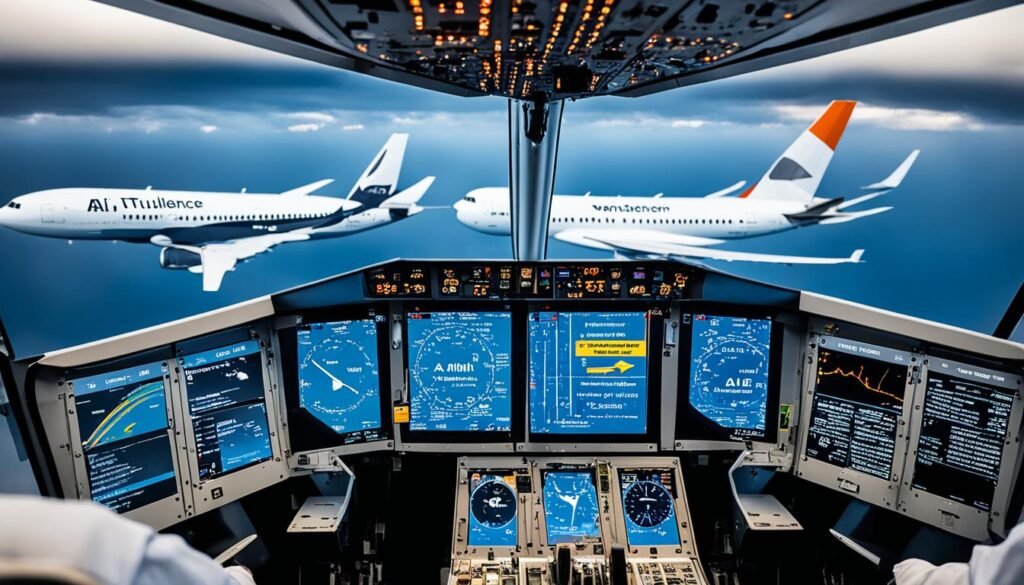
Robotic Co-Pilots: A Potential Solution
The aviation industry is looking into whether AI will replace human pilots. Robotic co-pilots could be a solution. They help human pilots by doing some flying tasks, which could save money and make flying safer. But, using robotic co-pilots has its challenges and downsides.
DARPA’s Robotic Co-Pilot Project
DARPA is working on a project for robotic co-pilots. The Defense Advanced Research Projects Agency wants to create AI-powered co-pilots to work with human pilots. These robots will handle tasks like navigating, planning flights, checking the plane’s health, and dealing with emergencies.
Benefits and Drawbacks of Robotic Co-Pilots
- Benefits:
- Could save money by needing fewer human pilots
- Make flying safer with constant checks and quick responses
- Make flying more efficient in everyday tasks
- Drawbacks:
- It’s expensive to make and add robotic co-pilots
- There are worries about how reliable they are and if they might break down
- Humans will still need to step in during important situations
Robotic co-pilots are an exciting idea but come with many challenges. As we look into this technology, we must think about the good and bad sides. This will help us make a safe and efficient future for robotic co-pilots aviation.
| Metric | DARPA Robotic Co-Pilot | Human Pilot |
|---|---|---|
| Response Time | Can react fast to emergencies and changes | May be slower in stressful situations |
| Endurance | Can work for a long time without getting tired | Limited by how long humans can stay awake and focused |
| Cost | Could save money over time | Has ongoing costs for salaries and training |
| Reliability | Has concerns about software problems and failures | Known for being reliable, with human judgment and decision-making |
Adding darpa robotic co-pilot tech to flying is complex, with both advantages and disadvantages robotic co-pilots. As flying evolves, using the best of human pilots and robotic co-pilots might lead to the safest and most efficient flying solutions.
Legal and Regulatory Considerations
The aviation industry is moving fast with AI technology. It’s important to follow strict legal and regulatory rules. These rules ensure AI technology is used safely and responsibly in flying.
Aviation Safety Standards and Regulations
The aviation world is very regulated to keep everyone safe. When adding AI to flying, we must follow these rules closely. Groups like the FAA and ICAO will set the rules for AI in flying.
Certification Processes for AI-Driven Aircraft
Getting AI-powered planes ready for flying is a big task. Old rules might not fit AI’s needs. We need new rules to check if AI flying tech is safe and works well.
| Key Regulatory Considerations | Potential Challenges |
|---|---|
| Aviation Safety Standards | Ensuring AI systems meet or exceed existing safety requirements |
| Certification Processes | Developing new certification frameworks for AI-powered aircraft |
| Cybersecurity Measures | Safeguarding aviation systems from cyber threats |
| Liability and Accountability | Determining responsibility in the event of AI-related incidents |
Adding AI to flying brings both good and tough parts from a legal and regulatory view. We must handle these well to make sure AI flying is safe and right.
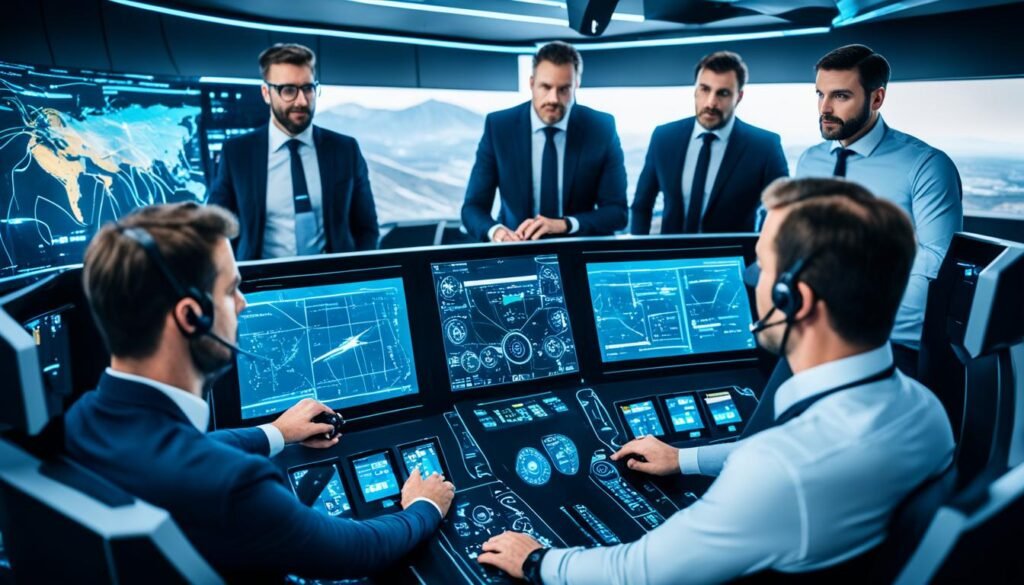
Cost and Economic Factors
AI-driven systems are changing the aviation industry. They come with big upfront costs. But, these costs could be lessened by the savings and efficiency gains later on.
AI can make flying cheaper, use resources better, and make things run smoother. Airlines and aviation companies could see big benefits from this.
Investment Required for AI-driven Aviation
Adding AI to aviation needs a lot of money. This includes building the right infrastructure and training AI. Experts say the industry could save up to $35 billion a year by cutting pilot costs.
Potential Cost Savings and Efficiency Gains
Using AI in aviation can save a lot of money and make things more efficient. Automated flight planning, predictive maintenance, and better operations can cut costs and use resources better.
Most people might not want to fly in a plane without a pilot. But, 27% of Americans might be okay with it. This shows there could be savings from fewer crew members.
| Potential Cost Savings and Efficiency Gains | Estimated Savings |
|---|---|
| Reduced Pilot Costs | Up to $35 billion per year |
| Improved Resource Utilization | Up to 5 flights managed by a single ground-based operator |
| Enhanced Operational Optimization | NASA’s “super-dispatcher” concept suggests a trained pilot could oversee flights of as many as a dozen aircraft at once |
The aviation industry is looking into AI-driven tech more and more. The cost and benefits will help decide how fast and how much they adopt it. Even with a big upfront cost, the long-term savings could change the industry a lot.
The Future of Aviation and AI
The future of flying will blend AI technology with human pilots, not replace them. AI will help pilots with tasks like planning flights and checking the plane. This will make flying safer and more efficient. But, we won’t see fully automated flights anytime soon.
How fast AI becomes a big part of flying depends on many things. These include new tech, rules, and how people feel about AI in flying. It will take a few years to get everything ready.
Gradual Integration of AI in Aviation
AI will slowly become a bigger part of flying. At first, it will help pilots with things like planning and navigating. As it gets better, AI might do more in flying. But, human pilots will still be key in emergencies and tricky situations.
Potential Timeline for Widespread Adoption
Experts say the AI in aviation market could hit USD 23 billion by 2031, up from USD 728.05 million in 2022. This shows AI will play a bigger role in flying. But, how fast it happens depends on tech progress, new rules, and people accepting AI in flying.
| Milestone | Estimated Timeframe |
|---|---|
| Increased AI-assisted flight operations | 1-3 years |
| Expanded use of AI for predictive maintenance and aircraft health monitoring | 2-5 years |
| Emergence of AI-powered robotic co-pilots | 5-10 years |
| Potential for fully autonomous flights, subject to regulatory approval | 10-15 years |
As we look into the future, adding AI to flying will be done carefully. This will keep flying safe and earn trust from the public.
“Artificial intelligence is crucial for developing autonomous drones capable of performing tasks human pilots do.”
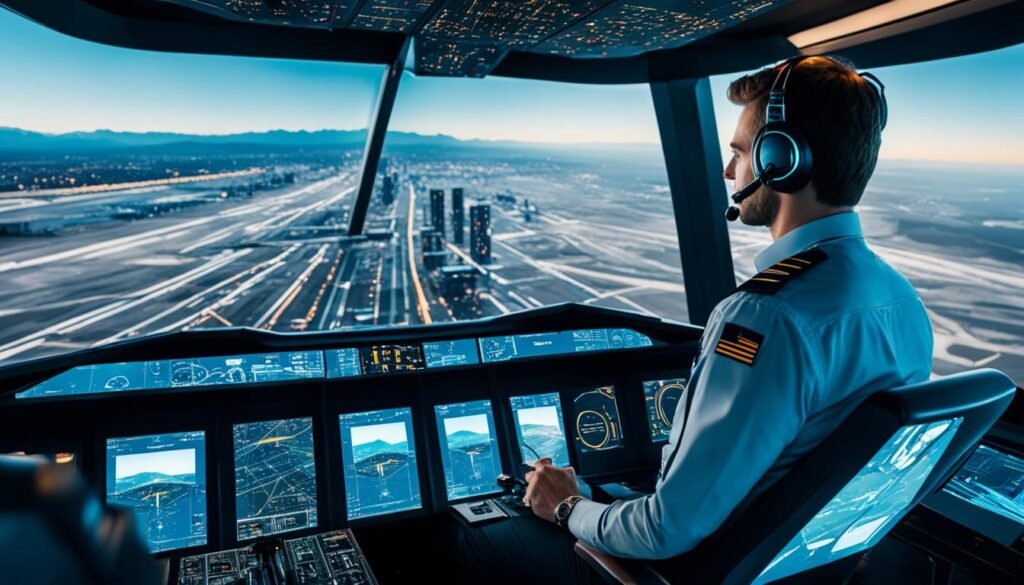
Conclusion
AI technology has made big steps in aviation, but human pilots are still key. They bring judgment, decision-making, and adaptability to the complex world of flying, especially in emergencies. AI and human pilots will likely work together in the future, making flying safer and more efficient.
The use of AI in aviation will take time due to technical, regulatory, and public concerns. Projects by Air France-KLM, Groupe ADP, and DARPA’s Air Combat Evolution show how AI can improve services, efficiency, and defense. But, AI must be balanced with human oversight to keep flying safe and trustworthy.
As aviation changes, the partnership between human pilots and AI will be vital. This partnership will bring new levels of efficiency, safety, and innovation. It will make flying better for passengers worldwide.
FAQ
Will AI replace pilots?
AI won’t replace pilots anytime soon. It will make flight search easier and help airlines fly more sustainably. But, human pilots are still key because they can make tough decisions in tricky situations.
How has AI been integrated into the aviation industry?
AI has changed the aviation world in many ways. It offers personalized experiences and helps with pricing and operations. It’s made flying safer and more efficient by improving things like flight planning and weather prediction.
What is the role of human pilots with the integration of AI?
With AI, human pilots and AI work together. AI helps with routine tasks and analyzing data. But, human pilots are still vital for making judgments and decisions, especially in emergencies.
What are the limitations of AI in the aviation industry?
AI has made big strides, but it’s not perfect yet. Aviation is complex and unpredictable, especially in emergencies. Human judgment and adaptability are still needed. Plus, getting to fully autonomous flights is hard due to legal and public acceptance issues.
What is the concept of robotic co-pilots?
Robotic co-pilots are a new idea. They’re part of projects like DARPA’s robotic co-pilot project. These systems help human pilots by doing some flying tasks, which could save money and make flying safer. But, they’re expensive and might not always work right, and humans still need to step in when it matters most.
What are the legal and regulatory considerations for integrating AI in aviation?
Adding AI to flying means dealing with a lot of laws and rules. Airlines must meet strict safety standards and get AI systems approved. These rules are important to make sure AI is used safely and responsibly.
What are the cost and economic factors involved in the integration of AI in aviation?
Using AI in flying costs a lot upfront. But, it could save money and make things more efficient over time. AI can help with maintenance and operations, making airlines more cost-effective.
What is the timeline for the widespread adoption of AI in the aviation industry?
AI will be added to flying slowly, not all at once. It will help human pilots, not replace them. How fast AI becomes common will depend on tech progress, rules, and what people think, which could take years.
